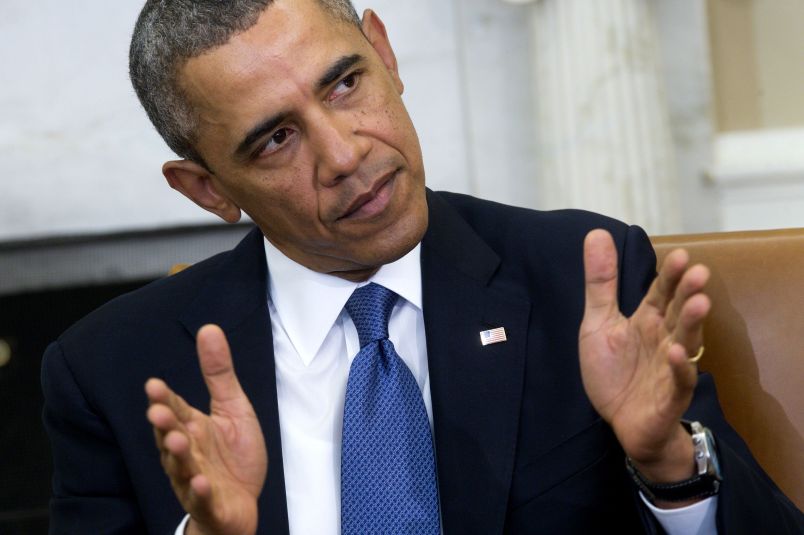Obamacare’s open enrollment ends next week. Soon after, the Obama administration will announce how many people — with a few caveats — signed up for private health coverage through the law for 2014.
At that point, the evaluation will truly begin. Some on the right will inevitably observe that the law fell well short of the original Congressional Budget Office projection of 7 million enrollees. Others on the left will likely counter that it still hit (or came close) to the revised 6 million projection that CBO made after the disastrous launch of HealthCare.gov. Charles Gaba, who has been tracking the enrollment process, anticipates 6.2 million enrollments.
None of that really matters. Health policy experts and insurance companies themselves agree that the raw number of enrollees isn’t really significant when the difference is 6 million versus 7 million. If nobody had signed up, that would have been a problem. But that didn’t happen.
The real data for measuring Obamacare’s success aren’t in yet, but they eventually will be. At the top of the list: What happens with premiums in 2015? Plus: Do insurance companies leave the market or enter it? And the ultimate barometer: Has the number of uninsured Americans dropped significantly?
In simpler terms: Did Obamacare, in year one, create a sustainable insurance market for the long term?
Making Obamacare work was always going to be a multi-year process. Before enrollment started, the CBO had estimated it would take three more years after 2014 to double the decrease in uninsured from 14 million to 28 million. Changes to the insurance market will also take a few years to shake out — but if it proves sustainable, the uninsured should get covered.
So for those looking to understand how the law is performing, ignore the spin sure to accompany the final enrollment numbers. These metrics are what policy experts and industry executives will be watching:
What happens to insurance premiums in 2015?
This has been an area ripe with significant speculation in recent weeks. An anonymous insurance executive warned The Hill that premiums would triple in some parts of the country. Another top executive said he anticipated double-digit increases. Worries about Obamacare’s risk pool — the balance between healthy and sick enrollees — are part of what’s driving the White House’s last-ditch effort to get young people to sign up before March 31. The demographic mix hasn’t been great so far. A bad risk pool could mean a big jump in premiums next year, though it’s important to remember that every state has its own.
The historical context is important, too: Health and Human Services Secretary Kathleen Sebelius has acknowledged that premiums would go up. “The increases are far less significant than what they were prior to the Affordable Care Act,” she told the House Ways and Means Committee.
That remains to be seen. But it is true that health insurance premiums were rising prior to Obamacare. This National Conference of State Legislatures table shows annual increases from 2004 to 2010. The question is whether premiums go up so much next year that coverage becomes unaffordable. They could. But the law also includes protections — namely, tax subsidies — that help reduce the costs that people actually pay. Any increases also have to be approved by the administration.
For 2015 plans, insurance companies are supposed to begin filing their premiums this May, so they’re likely already working on those calculations.
How do insurance companies behave?
This is tied to the premium question, but it’s a slightly different framing. Insurance companies obviously have the choice about whether to participate in Obamacare at all in terms of selling their product through HealthCare.gov and its state counterparts.
This year has given companies their first solid information about how the law is working, from an actuarial perspective. Now they’ll make the decision whether to stay, enter or bolt. The market could change significantly. In some states, such as Connecticut, some of the major insurers opted not to sell their plans on the state’s insurance marketplace. Did they see enough to decide it’s worth joining in? In others, a slew of new players have entered the market for the first time. Are they satisfied enough to stay?
The timeline here is again tied to the premium filings. Companies are already deciding what they’re going to do. If those already in the market stay and others come in, it should increase competition and help temper premium increases. A mass exodus, on the other hand, could lead to higher and higher premiums down the road.
Are the uninsured getting covered?
This, too, has already been subject to much debate. The uninsured aren’t the only people buying coverage through HealthCare.gov — some of those 10 million or so people who previously purchased on the individual market are shopping there, too. Some of them likely had their old plan cancelled and logged onto the Obamacare website to replace it.
But not all of the uninsured will enroll in private coverage. In states that expanded Medicaid under the law, a significant portion of the uninsured (about 40 percent nationally) probably qualified for the public insurance program and might have gotten covered that way.
The overall signs thus far are unclear. Gallup polling has shown the percentage of uninsured Americans dropping since Jan. 1, when Obamacare coverage took effect. Another survey found that only about 27 percent of enrollees in February were uninsured — but that was a significant increase from the first few months.









